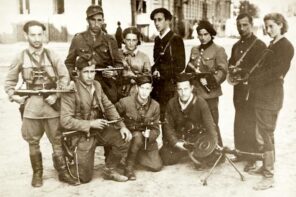Later this month more than 20,000 HIV activists and researchers will meet in Washington DC, 22 years after the last American gathering of the International AIDS Conference. With some 34 million men and women worldwide currently living with HIV/AIDS, it’s no longer possible to call the disease (as it was initially) a “gay plague.” It’s equally easy to forget amid growing support for gay marriage that just thirty years ago a sentence with the word “legal” modifying “same-sex relationships” was unimaginable. What happened?
The onset of AIDS and the religious community’s response to the epidemic transformed Americans’ attitudes toward homosexuality. But fundamental for the shift was the news media’s role in altering the narrative—a noteworthy outcome for an institution that claims to provide just the facts.
From the 1960s through the 1980s, most news outlets stigmatized, sensationalized, or ignored homosexuals (the straight world slowly adopted the term “gay” in the 1980s). In 1963, when the New York Times ran a front-page story on the growing presence of homosexuals in the city, the subtext was hostile, citing the “growing concern of psychiatrists, religious leaders and the police.” Soon afterward, when homosexuals organized protests against discriminatory employment practices, police entrapment, and raids on gay bars, the press paid scant attention. Even the iconic Stonewall riots, the June 1969 clashes between police and gays in New York’s Greenwich Village, were barely noted by the mainstream news. The Times’ piece was on page thirty-three and the Daily News’ story ran on page thirty.
Coverage expanded in the 1970s as gays and lesbians lobbied for civil rights and social acceptance. In 1973, when the American Psychiatric Association withdrew its classification of homosexuality as a “mental illness,” the change was widely reported as were the growing number of cities that added “sexual orientation” to anti-discrimination laws. By the end of the decade, reporters were filing profiles about a “hip” community with its own bars, clubs, music, and fashion as well as a distinctively uninhibited sexual scene. Journalists also covered an emerging religious backlash, coalescing in the 1977 “Save Our Children” campaign to rescind a Dade County, Florida anti-discrimination ordinance.
Both types of coverage set gay sexuality over and against monogamous heterosexual families. In stories such as the Florida repeal, opponents of homosexuality, like the campaign’s spokeswoman Anita Bryant, explicitly argued that the ordinance was immoral and anti-family. In articles about gays’ open sexuality, narratives implicitly set “us” against “them,” inviting readers to pruriently observe and judge gay behavior.
A Nameless Threat
Not surprisingly, a mysterious cancer that afflicted gay men did not initially strike mainstream journalists as newsworthy. In 1981, when physician Lawrence Mass wrote a story for New York Native, a small gay newspaper, the disease did not even have a name. Several weeks later, the Center for Disease Control (CDC) reported an outbreak of a rare cancer among a handful of gay men in Los Angeles. Soon after, mainstream news outlets briefly reported the findings but despite its rapid spread, the cancer, which would be identified as AIDS, did not receive ongoing or thorough coverage.
By 1982, nearly 800 AIDS cases had been diagnosed. According to one study, infants and children were increasingly infected. Although a threat to the general population was quickly dismissed, the implication was clear: anyone could be infected. The epidemic had exposed social and cultural fault lines that made coverage more than just a medical story. Its initial outbreak in the homosexual community made it a story about sexuality and religion, too. A majority of American Christians, including Roman Catholics, evangelicals, Mormons, and some mainline Protestants, believed that the Bible not only forbade homosexuality but also strongly condemned it. News outlets were reporting not only on the medical and scientific aspects of the disease but also discussing its social and cultural ramifications.
An emerging medical/moral frame for the disease made religion an integral part of the mix. In summer 1983, the Rev. Jerry Falwell declared that homosexuality was a sin and that AIDS was divine judgment against a nation that tolerated immorality. News outlets used the opportunity to quote a nationally-known religious leader and routinely repeated it throughout the decade. Even if divine wrath was unmentioned, Falwell’s other concerns—the homosexual threat to families and the need to proactively protect citizens from gays with AIDS—were. Stories also chronicled how AIDS divided churches: congregations angrily debated whether or not to use a common communion cup and if heterosexual marriage was biblically based.
As the decade progressed, coverage shifted from medical reports on the epidemic’s spread to feature stories on its human toll. Inasmuch as people with AIDS asked, Why me? and the unaffected wondered, What should I do?, religion suffused many stories. Reporters increasingly explored how religious folks met the pastoral and prophetic challenges posed by the crisis. Stories tracked faith-based responses: a Passover haggadah for people with AIDS; an AIDS outreach ministry for Southern Baptists, a gay black pastor launching programs for AIDS patients. Religious attitudes were in flux. A 1987 Gallup poll found that Roman Catholic and non-evangelical Christians were among “the strongest supporters of the rights of AIDS victims” and that 50 percent of the public (up 8 percent in four months) disagreed that AIDS was “a divine punishment for moral decline.”
Besides casting AIDS as a pastoral challenge, reporters also depicted it as a spiritual trial, replete with heterosexual martyrs and gay saints. The former were typically women who, infected by tainted blood or bisexual male partners, went public—hoping to educate others. Saints were gay men whose personal suffering become public performances of love and religious affirmation.
Sister Romana Marie Ryan was an early AIDS martyr. A “magically gifted” kindergarten teacher, she injured her knee on a class trip and was infected by a blood transfusion during surgery. Yet even as she faced death, Ryan prayed for the person whose blood she had received and hoped that her passing would spur the search for a cure. Belinda Mason, another martyr, was a “white, middle-class, non-drug-using heterosexual housewife from the mountains of Kentucky” who likewise received a tainted transfusion. Learning she had AIDS, Mason “dedicated her life to helping others understand the pain, fear, and tragedy.”
AIDS saints likewise modeled grace and courage. Unlike sufferers who said AIDS was a divine punishment, these men felt God’s love and yearned to share it. Not all saints were clerics or even religiously committed. In a series of stories about people who tested positive for the HIV virus, the Dallas Morning News included 23-year-old Charles, a gay intravenous drug user. Since learning his status, Charles stopped taking drugs and started helping people with AIDS. Although he did not belong to a religious group, he saw his work as a spiritual mission, telling the paper that “he was ‘standing in the way of the hand of God’ until he dedicated himself to helping people with AIDS.”
The Moral/Medical Axis
At the outset of the crisis, mainstream news outlets had marginalized AIDS coverage. The straight white men who staffed most newsrooms were uninterested in the gay community and assumed their view reflected the population-at-large. The only stories that roused them were marked by sensationalism or conflict. As the dimensions of the AIDS epidemic emerged, these two themes—gay libertinism and religious condemnation—became frames for seeing the disease as a moral as well as medical problem. Even stories that were not about religious responses to AIDS often evoked the moral/medical axis.
As the gay community responded to the crisis and heterosexual caregivers became involved, real life caught up to religious platitudes and many Christians reconsidered their position. When believers interrogated their faith, journalists reported their questions: Was God a God of love or judgment? Were biblical injunctions against homosexuality cultural artifacts or eternal truths? At the same time, AIDS spread into the straight community, infecting unsuspecting heterosexual partners, infants, and children, and weakening arguments that blamed the disease on immorality.
Reporters captured the crises of faith experienced by religious folks whose neighbors, friends, and family members were stricken with a disease that initially seemed a divine scourge. Did reassessing their theological position on AIDS enable some Christians to accept GLBT people as equals and to eventually see them as worthy of ordination and entitled to the sanction of marriage? Did reporting on these believers’ struggles around AIDS predispose other news consumers to rethink their own opinions? What about gays? Did the crisis affect their feelings about “straight” institutions such as religion and marriage, inadvertently fueling a desire to normalize? If so, did coverage of supportive congregations and loving families make a difference?
And what about reporting that perpetuated racist tropes? The news media repeatedly called out black churches as detached from the crisis. Despite the rising number of African Americans with AIDS, black congregations offered little comfort and even less outreach to the afflicted, according to press reports. Black churches were slow to respond, reporters noted, because most believed that homosexuality was a sin. Yet were black congregations any more homophobic than white churches with similar theology? If Jerry Falwell became the media’s right-wing go-to guy, the black churches served as its whipping boy.
Academics wrestle with the question of whether journalism reflects public opinion, shapes it or does a little of both. Insofar as religion influences attitudes about sexuality—which it does directly to the faithful and indirectly through cultural osmosis to many others—coverage of religious responses to AIDS offers provocative possibilities as well as ways to chart cultural change. In 1981, for example, few Americans would have taken seriously the possibility of gay marriage—including many gays, who would have scoffed at the notion that mirroring what they saw as an inherently (hetero)sexist, monogamous lifestyle could be a milestone on their own path to liberation. What caused the change? AIDS for one, evolving religious opinion for another, and—arguably—the news media’s role in bringing both to the public’s attention.




